Year at a glance
2012 was a strong year for TD, despite ongoing economic challenges and market volatility. Our total adjusted earnings were more than $7 billion — up about 10 per cent from 2011. Our results are a testament to the strength and resilience of our business model.
The highlights that follow tell a story of stability, strong leadership and growth, fuelled by our simple retail-focused strategy – to produce long-term, sustainable growth for our shareholders, customers and communities.
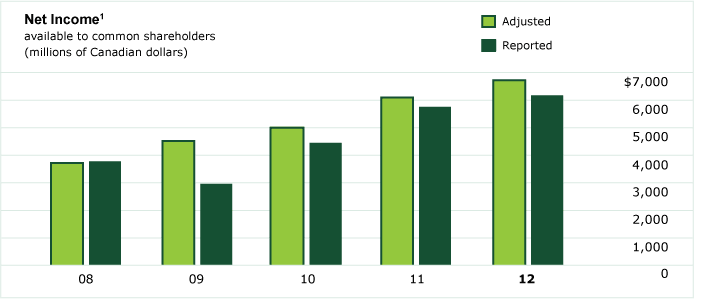
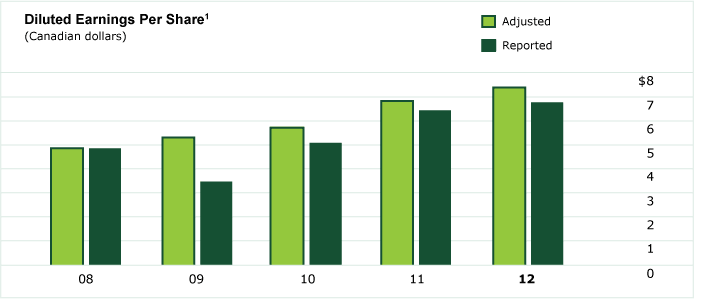
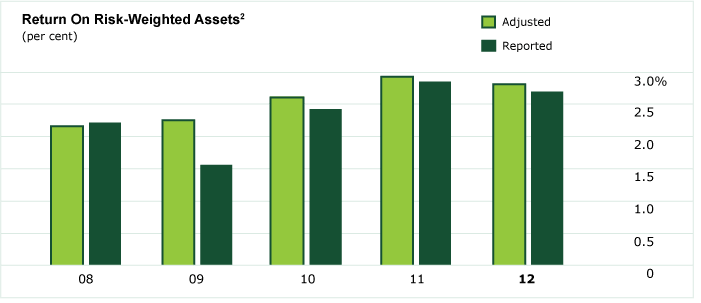
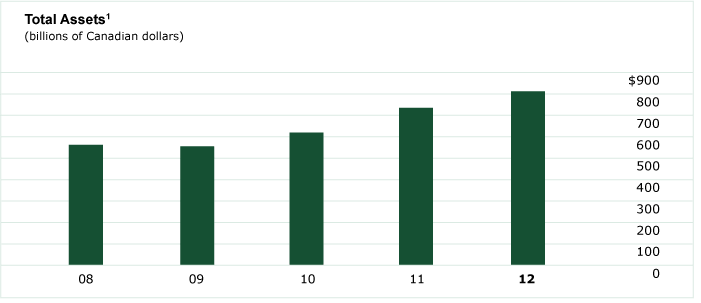
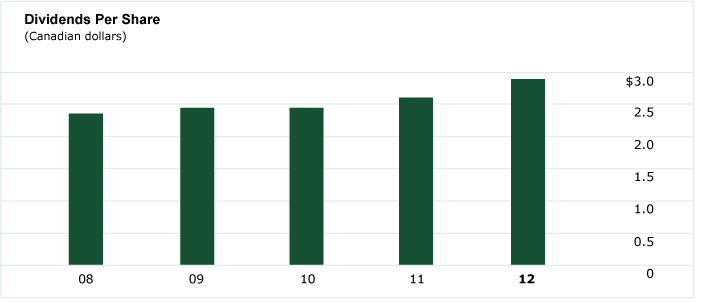
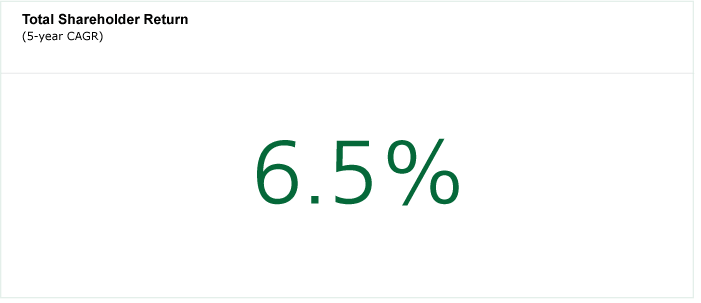
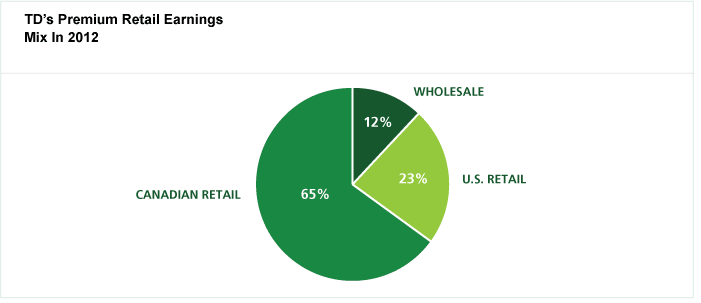
TD had the highest Total Shareholder Returns (TSR) among Big Five Canadian Banks
for the 3, 5 and 10 year time periods.3
TD Bank, America’s Most Convenient Bank®, grows store network
opening its 1,300th store; U.S. Personal and Commercial Banking has the 11th largest store network in the U.S.
TD increased its target dividend payout range to
40-50% from 35-45%
and raised dividends twice during fiscal 2012.
TD continued to invest in its growth businesses
announcing a deal to acquire Target’s U.S. Credit Card portfolio and enjoying market share gains in domestic commercial banking in fiscal 2012.
Our retail operations posted a record $6.2 billion
in adjusted earnings for 2012 or 88% of operating segment earnings.
TD Asset Management hits milestone
$200 billion in assets under management despite volatile markets in fiscal 2012.
TD Securities achieved a strong Return on Equity (ROE) of over 21%
despite tentative markets in fiscal 2012.
TD Insurance’s total premiums exceeded $3 billion for the third consecutive year
and TD Insurance remains the #1 direct writer of home and auto insurance in Canada.
Results prepared in accordance with GAAP are referred to as “reported.” Adjusted results (excluding “items of note,” net of tax, from reported results) and related terms are not defined terms under GAAP and, therefore, may not be comparable to similar terms used by other issuers. See “How the Bank Reports” in the accompanying Management’s Discussion and Analysis (MD&A) for further explanation, a list of the items of note and a reconciliation of non-GAAP financial measures.
The Bank transitioned from Canadian Generally Accepted Accounting Principles (Canadian GAAP) to International Financial Reporting Standards (IFRS) effective November 1, 2011. The Bank’s financial results for fiscal 2011 have been presented in accordance with IFRS for comparative purposes in the Bank’s 2012 Annual Consolidated Financial Statements and Management’s Discussion and Analysis (MD&A) (unless otherwise noted). Accordingly, the calculation of growth rates include balances in accordance with Canadian GAAP for the 2007 to 2010 financial years and balances in accordance with IFRS for 2011 and 2012.
“Five-year CAGR” is the compound annual growth rate calculated from 2007 to 2012 on an adjusted basis. “TD’s Premium Retail Earnings Mix” is based on adjusted results. “ Canadian Retail” earnings are the total adjusted earnings of the Canadian Personal and Commercial Banking and Wealth and Insurance segments. “U.S. Retail” earnings are the total adjusted earnings of U.S. Personal and Commercial Banking segment and TD Ameritrade Holding Corporation pickup.
Canadian peers/Big Five Canadian Banks include Royal Bank of Canada, Scotiabank, Bank of Montreal and Canadian Imperial Bank of Commerce. U.S. peers include Citigroup, Bank of America, J.P. Morgan, Wells Fargo, PNC Financial and U.S. Bancorp.
For purposes of comparison with U.S. peers, dividends per share five-year compound growth rate is calculated on a year-to-date basis from Q3 2007 to Q3 2012.
1 Based on Canadian Generally Accepted Accounting Principles (Canadian GAAP) for 2008 – 2010 and International Financial Reporting Standards (IFRS) from 2011 – 2012.
2 Based on Canadian GAAP for 2008 – 2011 and IFRS for 2012.
3 Big Five Canadian Banks based on Bloomberg for the period ended Oct. 31, 2012. Please note TD is tied for first with respect to the 3 year CAGR.
| (millions of Canadian dollars, except where noted) | 2012 | 2011 |
|---|---|---|
| Results of operations | ||
| Total revenue – reported | $ 23,122 | $ 21,662 |
| Total revenue – adjusted | 23,253 | 21,535 |
| Net income – reported | 6,471 | 6,045 |
| Net income – adjusted | 7,075 | 6,432 |
| Financial positions at year-end | ||
| Total assets $B | 811.1 | 735.5 |
| Total deposits $B | 487.8 | 449.4 |
| Total loans net of allowance for loan losses $B | 408.8 | 377.2 |
| Per common share (Canadian dollars) | ||
| Diluted earnings – reported | 6.76 | 6.43 |
| Diluted earnings – adjusted | 7.42 | 6.86 |
| Dividend payout ratio – adjusted | 38.7% | 37.7% |
| Closing market price (fiscal year end) | 81.23 | 75.23 |
| Total shareholder return (1 year) | 11.9% | 5.7% |
| Financial ratios | ||
| Tier 1 capital ratio5 | 12.6% | 13.0% |
| Total capital ratio5 | 15.7% | 16.0% |
| Efficiency ratio – reported | 60.5% | 60.2% |
| Efficiency ratio – adjusted | 56.6% | 57.5% |
Results prepared in accordance with GAAP are referred to as “reported.” Adjusted results (excluding “items of note,” net of tax, from reported results) and related terms are not defined terms under GAAP and, therefore, may not be comparable to similar terms used by other issuers. See “How the Bank Reports” in the accompanying Management’s Discussion and Analysis (MD&A) for further explanation, a list of the items of note and a reconciliation of non-GAAP financial measures.
The Bank transitioned from Canadian Generally Accepted Accounting Principles (Canadian GAAP) to International Financial Reporting Standards (IFRS) effective November 1, 2011. The Bank’s financial results for fiscal 2011 have been presented in accordance with IFRS for comparative purposes in the Bank’s 2012 Annual Consolidated Financial Statements and Management’s Discussion and Analysis (MD&A) (unless otherwise noted). Accordingly, the calculation of growth rates include balances in accordance with Canadian GAAP for the 2007 to 2010 financial years and balances in accordance with IFRS for 2011 and 2012.
“Five-year CAGR” is the compound annual growth rate calculated from 2007 to 2012 on an adjusted basis. “TD’s Premium Retail Earnings Mix” is based on adjusted results. “ Canadian Retail” earnings are the total adjusted earnings of the Canadian Personal and Commercial Banking and Wealth and Insurance segments. “U.S. Retail” earnings are the total adjusted earnings of U.S. Personal and Commercial Banking segment and TD Ameritrade Holding Corporation pickup.
Canadian peers/Big Five Canadian Banks include Royal Bank of Canada, Scotiabank, Bank of Montreal and Canadian Imperial Bank of Commerce. U.S. peers include Citigroup, Bank of America, J.P. Morgan, Wells Fargo, PNC Financial and U.S. Bancorp.
For purposes of comparison with U.S. peers, dividends per share five-year compound growth rate is calculated on a year-to-date basis from Q3 2007 to Q3 2012.
1 Based on Canadian Generally Accepted Accounting Principles (Canadian GAAP) for 2008 – 2010 and International Financial Reporting Standards (IFRS) from 2011 – 2012.
2 Based on Canadian GAAP for 2008 – 2011 and IFRS for 2012.
3 Big Five Canadian Banks based on Bloomberg for the period ended Oct. 31, 2012. Please note TD is tied for first with respect to the 3 year CAGR.
5 In fiscal 2011, capital ratios are calculated based on Canadian GAAP.
Performance indicators focus effort, communicate our priorities and benchmark TD’s performance as we strive to be The Better Bank. The following table highlights our performance against these indicators.
| 2012 performance indicators | Results6 |
|---|---|
| Financial | |
|
|
| Business operations | |
|
|
| Customer | |
|
|
| Employee | |
|
|
| Community | |
|
|
Results prepared in accordance with GAAP are referred to as “reported.” Adjusted results (excluding “items of note,” net of tax, from reported results) and related terms are not defined terms under GAAP and, therefore, may not be comparable to similar terms used by other issuers. See “How the Bank Reports” in the accompanying Management’s Discussion and Analysis (MD&A) for further explanation, a list of the items of note and a reconciliation of non-GAAP financial measures.
The Bank transitioned from Canadian Generally Accepted Accounting Principles (Canadian GAAP) to International Financial Reporting Standards (IFRS) effective November 1, 2011. The Bank’s financial results for fiscal 2011 have been presented in accordance with IFRS for comparative purposes in the Bank’s 2012 Annual Consolidated Financial Statements and Management’s Discussion and Analysis (MD&A) (unless otherwise noted). Accordingly, the calculation of growth rates include balances in accordance with Canadian GAAP for the 2007 to 2010 financial years and balances in accordance with IFRS for 2011 and 2012.
“Five-year CAGR” is the compound annual growth rate calculated from 2007 to 2012 on an adjusted basis. “TD’s Premium Retail Earnings Mix” is based on adjusted results. “ Canadian Retail” earnings are the total adjusted earnings of the Canadian Personal and Commercial Banking and Wealth and Insurance segments. “U.S. Retail” earnings are the total adjusted earnings of U.S. Personal and Commercial Banking segment and TD Ameritrade Holding Corporation pickup.
Canadian peers/Big Five Canadian Banks include Royal Bank of Canada, Scotiabank, Bank of Montreal and Canadian Imperial Bank of Commerce. U.S. peers include Citigroup, Bank of America, J.P. Morgan, Wells Fargo, PNC Financial and U.S. Bancorp.
For purposes of comparison with U.S. peers, dividends per share five-year compound growth rate is calculated on a year-to-date basis from Q3 2007 to Q3 2012.
1 Based on Canadian Generally Accepted Accounting Principles (Canadian GAAP) for 2008 – 2010 and International Financial Reporting Standards (IFRS) from 2011 – 2012.
2 Based on Canadian GAAP for 2008 – 2011 and IFRS for 2012.
3 Big Five Canadian Banks based on Bloomberg for the period ended Oct. 31, 2012. Please note TD is tied for first with respect to the 3 year CAGR.
5 In fiscal 2011, capital ratios are calculated based on Canadian GAAP.
6 Performance indicators that include an earnings component are based on TD’s full-year adjusted results (except as noted) as explained in “How the Bank Reports” in the accompanying MD&A. For peers, earnings have been adjusted on a comparable basis to exclude identified non-underlying items.
7 Total shareholder return is measured on a one-year basis from November 1, 2011, to October 31, 2012.
8 Return on risk-weighted assets measured YTD as at July 31, 2012, for comparison purposes. TD’s return on risk-weighted assets for 2012 was 2.83%.
9 CEI is a measurement program that tracks TD customers’ loyalty and advocacy.
10 Scale for employee engagement score is from one to five.
11 Calculated based on Canadian Cash Donations/five-year rolling average domestic net income before tax.
12 Includes a one-time donation of $500,000 from TD Friends of the Environment Foundation to The Nature Conservancy of Canada in support of the TD Forests program.
